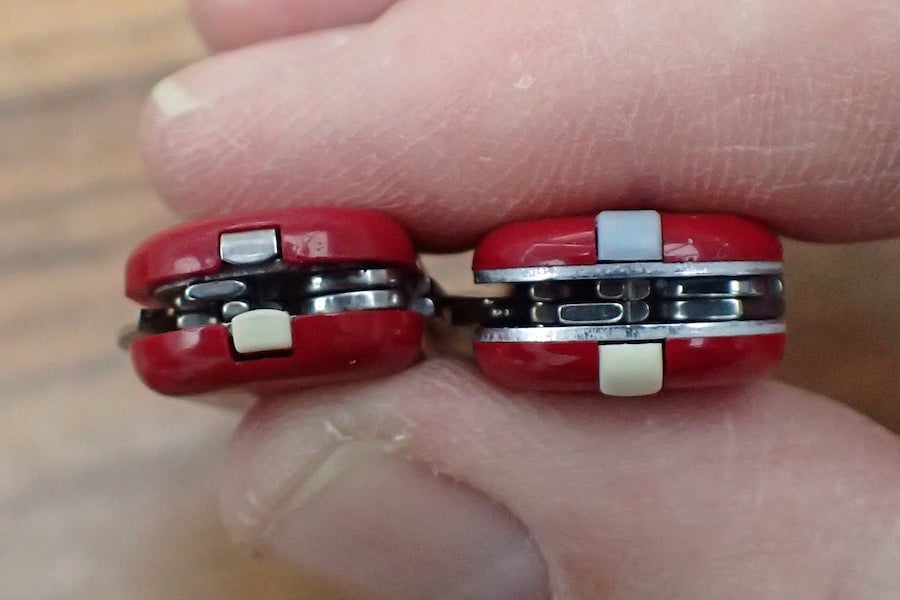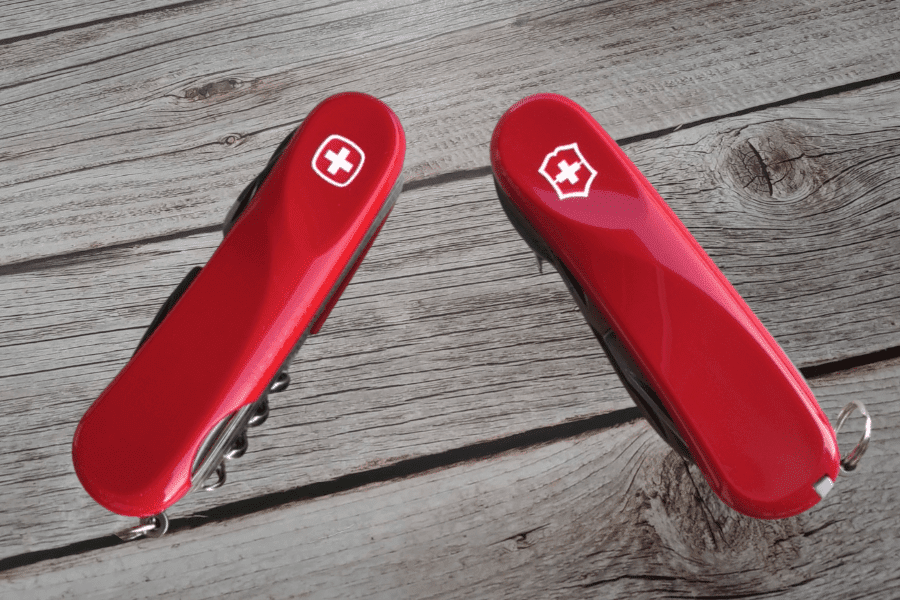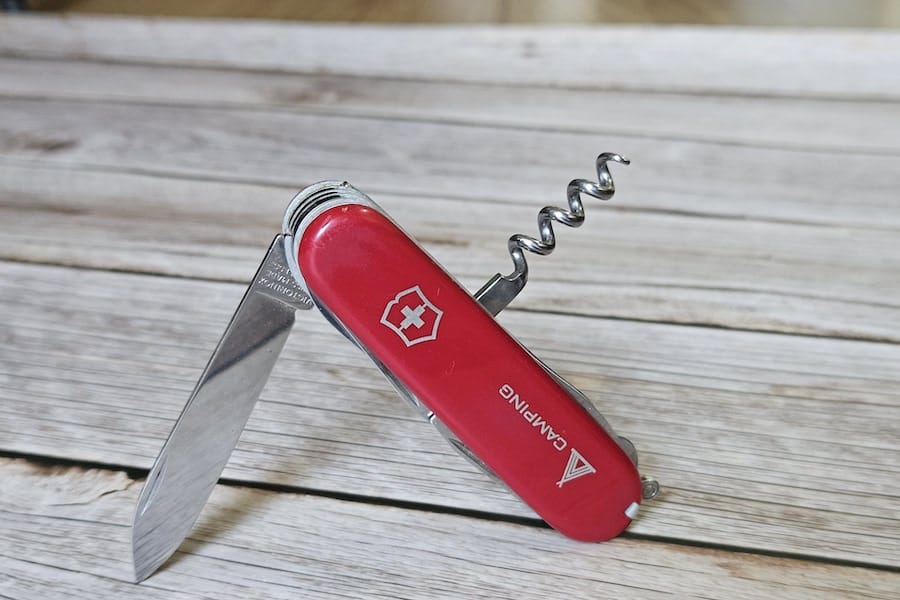The Victorinox Delemont Collection is often regarded as the continuation of Wenger’s Swiss Army Knife but under Victorinox branding.
While this is true to a certain extent, there are certain differences between the original Wenger design and the Delemont Collection design for the same model of the Swiss Army Knife. Interestingly, these differences are somewhat in line with how a Victorinox SAK differs from a Wenger SAK.
To me, it looks like Victorinox not only changed the logo but also introduced some of its own design and tools thereby somewhat hybridizing the Wenger design. Let’s have a look at some of the key differences in this Wenger vs. Delemont comparison.
1. The Can Opener
Victorinox replaced the Wenger can-opener with its own. Yes, you won’t find the hook-shaped can opener that Wenger uses in all of its SAKs in any of the Delemont Collection SAKs.
The Wenger can opener has a long sharp edge that could even be used as a secondary blade.
The Victorinox can opener found in the Delemont Collection has the advantage of having a 3mm flathead screwdriver tip that also works on some Philips screws.

This is a significant departure from the Wenger design, as the can opener is one of those tools that is so different in Victorinox and Wenger SAKs.
I have seen people preferring Vic over Wenger, and vice-versa, just because of how the can opener looks in their respective Swiss Army Knives.
Note that The two can openers also work a bit differently (see box).
The Wenger can opener is worked towards the user, clockwise around the can. The Vic Delemont can opener is worked away from the user, anti-clockwise around the can.
Each has its own advantages/disadvantages of course. But this does mean that the Wenger can opener is now extinct in Swiss Army knives.
2. The Punch
Another tool that is going to be extinct in Swiss Army Knives is the Wenger punch. Yes, you guessed it right. The Delemont Collection uses the Victorinox-style punch.
The sharpened edge of the Vic punch works more like a reamer. It also has a sewing-eye hole that makes it possible to be used as an awl.
The Wenger design without any sharpened edges looks and works more like a traditional punch.

I have seen that the Wenger punch makes cleaner holes in most materials compared to the Vic reamer/awl. The Vic reamer/awl is more aggressive however and works faster on harder materials (leather, wood, etc.).
I find the Victorinox-style reamer more useful, to be honest. The extra function it has of being an awl can come quite handy sometimes. You may read more about this in this post.
But there is no denying that by replacing the Wenger punch, Victorinox has removed another distinguishing feature of a Wenger SAK from the Delemont Collection.
3. Toothpick and Tweezers Placement
The Delemont Collection SAKs keep the scale tools, viz. the toothpick and the tweezers, similar to how these are placed in Vic SAKs, rather than Wenger SAKs.
Wenger SAKs keep the toothpick and the tweezers in slots beneath the lip of the scales, almost invisible on the outside.
The Delemont Collection SAKs however, like all Vic SAKs, keep them very visible from the outside in their respective slots.

The advantage of the Vic design is that the tools are easily accessible from the cutouts at the top edges of the scales. In the Wenger, you have to depend on your nails a lot to pull the toothpick and tweezers out from the slots.
But again, just because of how difficult it is to get them out, the Wenger placement also makes the scale tools difficult to lose.
I find the Vic design slightly superior in this regard, not just because of better accessibility, but also because the tip at the end of the scale tools are also slightly larger and hence easier to work with.
4. The Scales
The Delemont Collection uses the Wenger style of Evo and EvoGrip scales but with a subtle difference. The scales do not wrap around the metal frame of the SAK.
If you have handled a Wenger SAK before, you will immediately feel the difference once you grip a Delemont Collection SAK.
The scales on the Vic Delemont knives, instead of wrapping around the liners, sit flush on top of the liner. This makes the SAK a tiny bit thinner and the design looks more streamlined.

The two designs have different look-and-feel, and I don’t have a particular preference here.
But going by Vic’s reputation of quality, my understanding is that Vic probably thinks the flush-on-top scale design is better and more durable.
5. Branding – The Logo and Tang Stamp
Vic puts the Victorinox logo on the scales of the Delemont Collection SAKs, and the Victorinox stamp on the tang of the main blade. After all, the Delemont Collection are Vic-branded Swiss Army Knives.
Note that Vic did not change the design of the main blade, however. In the 85mm range, the blade is thinner with a broader belly compared to Vic blades, just like in Wenger 85mm.
Only the tang stamp reminds you that it is a Vic SAK, not a Wenger SAK.

Of course, this change in branding doesn’t make any difference in functionality.
6. Quality Control
This may not be a visible difference, but it is often considered one of the most significant differences between an original Wenger SAK and a Vic Delemont Collection SAK. The Delemont Collection SAK is better constructed than a Wenger SAK.
While Wenger has been a formidable rival to Victorinox for many years and was arguably more innovative, Victorinox always had a slight upper hand when it came to quality control.
It is said that when Vic acquired Wenger but allowed it to run independently for many years, they did influence the quality of Wenger knives for the better.
Wenger SAKs were good quality of course, by Vic is slightly better in this department. Better quality control in Vic knives compared to that in Wenger has been admitted often by many SAK enthusiasts.
With the Delmont Collection, Victorinox has brought that slight edge in quality and merged it with the Wenger design. This has arguably made the Delemont Collection SAKs the pinnacle of Swiss Army Knife quality.
One thing, however, has remained the same with the Vic Delemont collection. I know Wenger knives had always cost more than their equivalent Victorinox models. Unfortunately for SAK lovers and consumers like us, the Vic Delemont collection SAKs are also dearer than their equivalent non-Delemont models. The availability is also a bit of a concern.
Hopefully, Victorinox will be able to address both these issues by scaling up the production of Delemont Collection knives.
Conclusion
Wenger Swiss Army Knives are extinct now, and some of the best Wenger knife models will never be made again in the famous Delemont factory situated in the Jura region of Switzerland.
Vic has openly admitted that it has made changes to the engineering of the Delemont knives from the original Wenger design. But it is widely believed that this has improved the quality.
If you want to know more about Wenger’s history, read this post.

I am happy that the legacy of Wenger’s SAKs will live on in the Victorinox Delemont Collection to some capacity.






